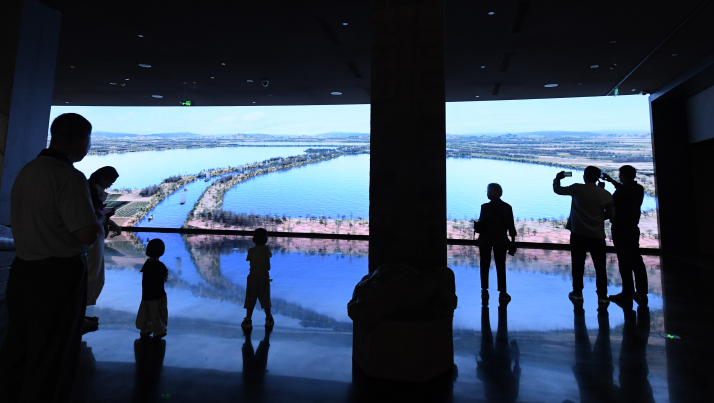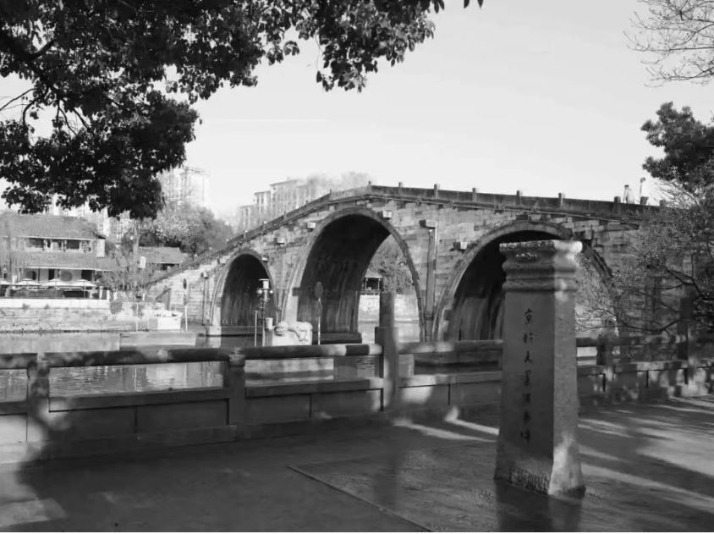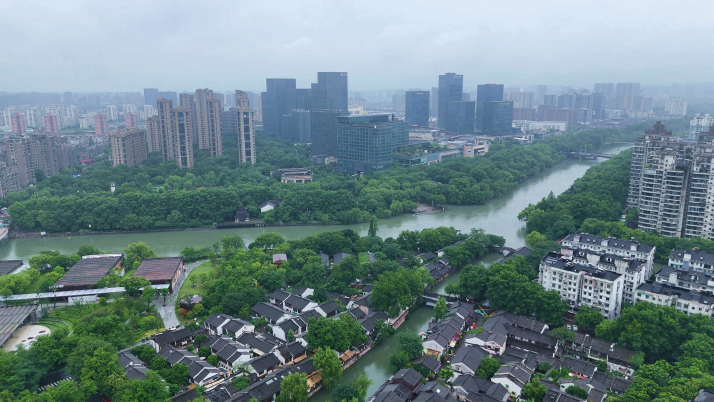| China |
| Aging like a fine waterway | |
|
|
 Visitors explore exhibitions at the China Grand Canal Museum in Hangzhou, capital of Zhejiang Province, on June 12, 2024 (XINHUA)
The Grand Canal, the world's longest artificial waterway, is the epitome of China's cultural heritage. This year sees the 40th anniversary of China's accession to the World Heritage Convention and the beginning of the second decade since the Grand Canal's inscription as a UNESCO World Heritage Site in June 2014. Public commitment to the preservation of this canal, the first segments of which were dug in the fifth century B.C., now thrives along its 1,800-km span. From Beijing in the north to Hangzhou in the south, stories of the canal's protection and utilization abound, with one of its liveliest chapters unfolding in Gongshu District, Hangzhou of Zhejiang Province, east China. Memory and innovation "Grain transport was one of the Grand Canal's paramount functions, especially during the Yuan, Ming and Qing dynasties (1271-1911), " explained Lou Hongyan, a staff member at the Beijing-Hangzhou Grand Canal Museum in Hangzhou, highlighting the canal's core historical value. The sophisticated water conservancy and navigation system formed a foundation for Hangzhou's ancient prosperity. Hangzhou's Gongchen Bridge, the southern starting point of the Beijing-Hangzhou Grand Canal, is a three-arch stone bridge first constructed in 1631. It once witnessed the arrival and departure of countless grain transport vessels. Today, the area west of the bridge, once an industrial hub, is undergoing a metamorphosis. The Living Handicraft Museum, transformed from a workshop of the Tongyi Gong Yarn Mill (later renamed the Hangzhou No.1 Cotton Mill), epitomizes this change. It is not only Zhejiang's first comprehensive museum integrating interactive learning, intangible cultural heritage handicraft experiences and folk art performances, but also a prominent platform attracting artisans from across the province and the nation for exchange. Not far away, at the Beijing-Hangzhou Grand Canal Museum—the country's first large-scale thematic museum dedicated to canal culture—Curator Yang Yujia contemplates deeper integration. "Merging museums and technology isn't about pursuing flashy effects or visual impact," Yang told Beijing Review. "It requires comprehensive, deep integration across cultural relic protection, exhibition design, visitor services and educational outreach." According to Yang, museums must maintain their cultural core, utilizing technology as a tool to express culture through new technological languages. "This is both the trend for and challenge facing museums," she said. Stepping into the museum, visitors embark on a journey northward from the Gongchen Bridge, through Suzhou and Yangzhou in Jiangsu Province, finally reaching Beijing, as the grand historical panorama of the Grand Canal gradually unfolds. Through detailed historical records and realistic scene reconstructions, one witnesses the immense toil of countless laborers carving the waterways and can instantly sense the canal's formidable power in facilitating economic and cultural exchange between north and south. "The areas along the canal is exceptionally rich in intangible cultural heritage resources. The urgent task is to effectively protect and promote them," Xu Hanling, an official of Gongchen Subdistrict in Gongshu, told Beijing Review. "We aim to retain ancient charm within the urban landscape, allowing this heritage to develop in sync with modern trends." Gongshu boasts three specific segments of the Grand Canal that are officially recognized as part of the UNESCO World Heritage Site. It is also home to three other heritage sites and over 23 industrial heritage sites. "These old factory buildings, bearing the city's memory, are mostly structurally sound and spacious, offering strong potential for adaptive reuse," Xu said. These robust spaces are being imbued with new cultural missions. What were once manufacturing sites such as the Hangzhou Native Produce Warehouse and the Hangzhou Honglei Silk Factory now house the China Knives, Scissors and Swords Museum, the China Fan Museum, the China Umbrella Museum and the Hangzhou Arts and Crafts Museum, creating a cluster of national-level museums.  The Gongchen Bridge in Hangzhou in 2025 (CHEN YUN)
The flow of daily life Since the canal's World Heritage inscription in 2014, the Gongchen Bridge area has become a bustling tourist destination, where cafe culture has truly flourished. Cafes play multiple roles: Those east of the bridge serve as community hubs fostering neighborly bonds; west of the bridge, cafes steeped in the museum cluster's ambiance become annotations to the canal's cultural lineage. Moreover, many chain brands offer patrons "morning coffee, evening alcohol." Just picture this: A 15-yuan ($2) takeout coffee from Chinese specialty coffee chain MANNER coexists harmoniously with the mellow moments of evening livehouse music, and the traditional lidded-bowl tea of long-time residents sits alongside the Geisha coffee favored by their new (temporary) neighbors. The mottled walls of industrial relics contrast with the clean lines of modern design. "We also have a bookstore themed on Nanpai Sanshu (a pen name translated to 'Uncle Three'), author of The Grave Robbers' Chronicles and Legend of Zanghai. The latter's TV adaptation was a recent major hit loved by audiences at home and abroad," Xu told Beijing Review. Intangible cultural heritage workshops, cafes and cultural creative shops stand side by side in the block. Beneath the bridge, the canal water buses shuttle back and forth day after day. "This place is not merely a container of history; it is a vibrant locale brimming with life and local flavor," Xu added. Beyond the lively scenes at brick-and-mortar museums, the Grand Canal Digital Image Gallery offers a quieter perspective. Twenty-four coolly displayed grey-toned images use rich gradations to meticulously depict details along the canal banks—familiar scenes rendered with an intriguing sense of detachment. In 2025, artist Chen Yun, adopting a field study approach, visited every heritage site along the Grand Canal's Zhejiang section, creating a visual archive. "This series represents the artist's attempt to use imagery to explore the dialogue between past and present," Xu explained. At the exhibition, one visitor pointed to an image labeled "Site of Tongyi Gong Yarn Mill" and remarked, "This is where I once worked." This mill, established in the late 19th century, witnessed the development of Zhejiang's modern national industry. Nearby, an elderly gentleman stood before an image of Fuyi Granary, he smiled and said, "Isn't this where I practice Tai Chi?" The seemingly cold imagery was instantly warmed by personal memories.  The Grand Canal section in Gongshu District, Hangzhou, on June 12 (CHEN ZHICHAO)
The soul of the canal Today under Gongchen Bridge, the canal flows ceaselessly, while container-laden cargo ships move steadily toward the Qiantang River, demonstrating the canal's ongoing economic role in connecting north and south. At the opening ceremony of the 2025 China Grand Canal Culture Belt Beijing-Hangzhou Dialogue in May, cultural scholar Meng Man, a professor of literature at Minzu University of China, said, "Canals like China's Grand Canal, the Suez Canal, and the Panama Canal are not gifts of nature. They are monumental human creations, born from the dream of connection and exchange, constantly overcoming geographical barriers. This pioneering spirit, this drive to transcend limits, is the very soul of the Grand Canal." Han Meilin, a Tsinghua University professor of art who grew up along the canal's banks in Shandong Province, east China, said with deep affection at the ceremony, "The canal transported not only the produce and wealth of the south to the north, and the population and technology of the north to the south. More importantly, it wove together the local customs, folk arts and cultures of different places into a splendid, colorful tapestry. The canal deserves to be known by the world. There are simply too many stories along its banks." BR (Reporting from Hangzhou, Zhejiang Province) Copyedited by Elsbeth van Paridon Comments to taozihui@cicgamericas.com |
|
||||||||||||||||||||||||||||
|